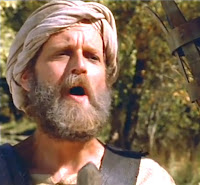Comment #1: “If I have read your Book of Mormon correctly, it seems there were more than one prophet in the days of Lehi. Why more than one? You only have one today” Jesse B.
Response: There are almost always more than one prophet on the earth at one time. Currently, there are 15 men on the earth set apart as Prophets, Seers, and Revelators. What makes the President of the Church unique is that he is the only man on earth who has authority to exercise all the keys of the priesthood, even though those keys were given to him when he was first ordained an apostle. However, today's organization of prophets is much different than in Lehi's day.
Elijah was called to preach repentance to the northern kingdom of Israel during the reigns of Kings Ahab and Ahaziah
In the Old Testament (Lehi’s time), there was no "President of the Church." The presiding priesthood authority under the Mosaic Law was the high priest of the Aaronic Priesthood (2 Kings. 22:8; Nehemiah. 3:1). Since the ecclesiastical institution of the time was governed by the Aaronic Priesthood, these prophets (most of whom had been obtained the Melchizedek priesthood through personal righteousness) were not ecclesiastical administrators in the same sense that they are today. Rather, they received mandates from the Lord to perform specific prophetic functions.
In the Old Testament it speaks of a band of prophets meeting Samuel, who prophesied with the other prophets (1 Samuel 10:10-11). These prophets had specific assignments (callings). As an example, the prophet Jonah was commanded of the Lord to preach repentance to the city of Nineveh. Lehi was commanded to prophecy to the Jews regarding their impending destruction and to call them to repentance.
Other Old Testament prophets were given special callings to counsel the king in conjunction with their responsibility to cry repentance to the people, such as Jeremiah in Lehi’s day (as well as Samuel, Nathan, and Isaiah). They may have been the major prophets of their day but they were not the administrative leaders of the religious organization under Mosaic Law.
“Surely the Lord God will do nothing, but he
revealeth his secret unto his servants the prophets” Amos 3:7
Comment #2: “Where is your narrow neck of land?”
Response: Because of the very makeup of the western Andean area, between the mountains and the sea being a narrow strip in the south and much wider in the north, with the Gulf narrowing it to an area about 25-30 miles between the gulf waters and the steep Andes of Guayaquil separating Ecuador and Peru, actually cutting off land movement and mountains, the nature of the land has always been considered divided in these two large areas.
Even today, with the Andes up all along the eastern edge of the western shelf, the inhabitants consider south America divided in two halves: The Western area which is Ecuador Colombia, Peru, western Bolivia, and Chile separate from the rest of the continent that is east of the Andes.
Left: The Land of Promise as an island in South America. The Narrow Neck
of Land is that area to the east of the Gulf of Guayaquil between the West Sea
and the East Sea. When the land came up as the (red line) Andes rose (to a
height which is great), the narrow neck remain between the West Sea and the
tall Andes Mountains
Comment #3: “I read a paper from one of the professors at BYU named Clark who said he was convinced that the reference to a north and a south sea was ‘devoid of any concrete geographical content’ (his words), and claims that all specific references to seas in the Book of Mormon are only to a west and east sea. He also feels any model, such as yours, that shows a north and south sea is doomed to fail” Pete A.
Response: John E. Clark is a professor of archaeology in the department of anthropology at BYU where he received both is B.S. and M.A., though obtaining his PhD at Michigan. He wrote in his book: The Book of Mormon and Archaeology (New World Archaeological Foundation, BYU, May 25, 2004) in addition to your comment, that “…we cannot dismiss the reference to these seas out of hand. If they are metaphorical, what was the metaphor? (p 65).
As a Mesoamericanist, specializing in the Olmec culture, it is only reasonable for him to try and eliminate, downplay, or put in question a north and south sea, since Mesoamerica only has an east and west sea. He also wrote: “Conceptually, beyond each wilderness lay a sea, south, north, west, and east. Thus the land was conceived as surrounded by seas, or floating on one large sea” (p 65), though we do not agree with his “conceptual” comment, as though Jacob did not know what he was talking about, or Nephi either who wrote it down, that the Land of Promise was an island (2 Nephi 10:20), which fits his picture quite well.
Mormon also understood this when he talked about the Nephites expanding from sea to sea (Helaman 3:8).
This is not the first time we have disagreed with Clark regarding the scriptural record, and it is not likely to be the last. Unlike most theorists, especially those of Mesoamerica, we stand behind and support totally the scriptural record and do not adjust the clear and concise descriptions to meet one’s beliefs, opinions, or models to relegate Mormon’s writings to asking meaningless questions and comments.
Unlike Clark, we do not look at the scriptural descriptions as metaphors, i.e., not literally applicable. Nor is there any reason to believe such writing is metaphorical, figurative or symbolic in any way.








No comments:
Post a Comment